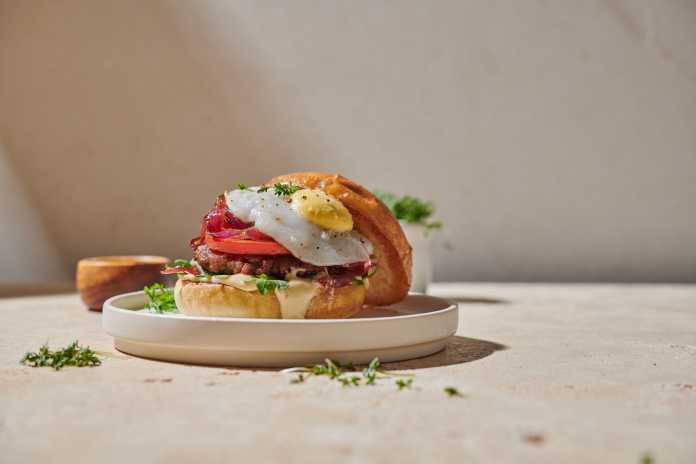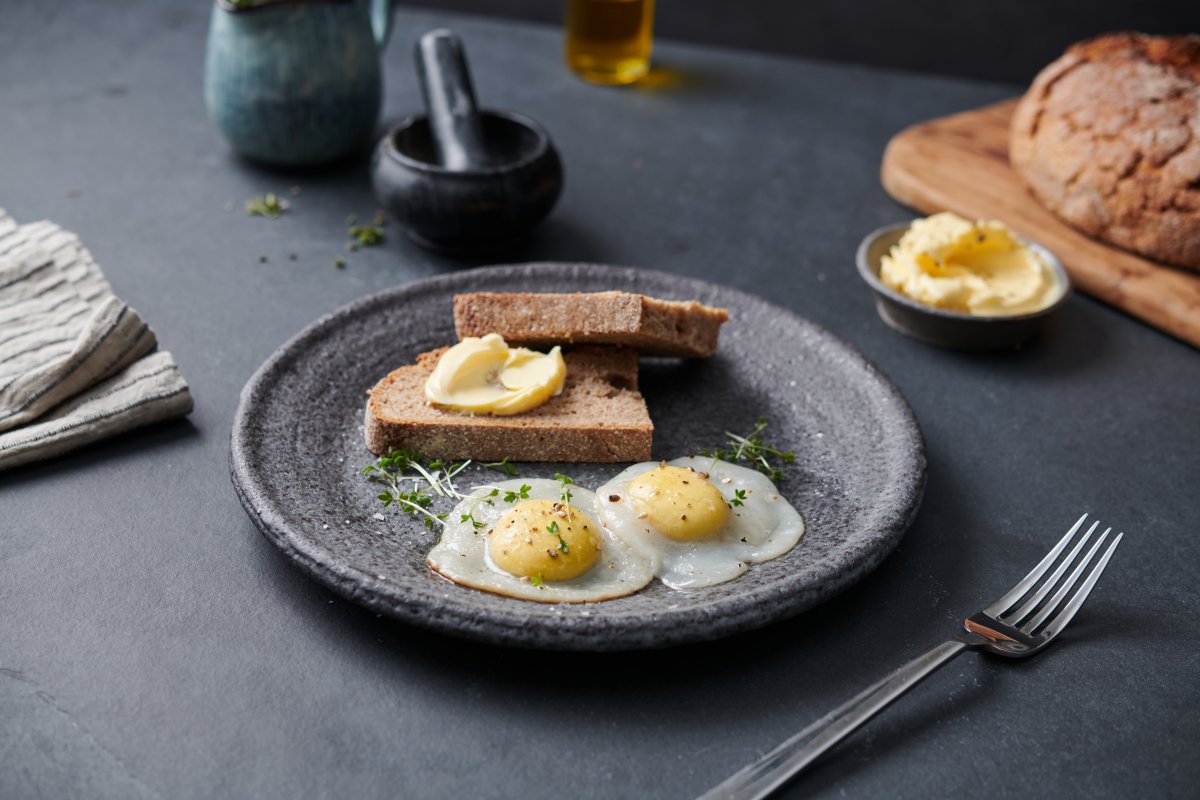Tortillas with green tomato sauce and fried eggs: The dish has long been one of Verónica García-Arteaga’s favorite dishes. But since the food technologist from Mexico has been vegetarian, the ingredient “fried egg” has been a problem. Or rather: it was her. Because Garcia-Arteaga has developed a vegan alternative at the Fraunhofer Institute for Process Engineering and Packaging (IVV) in Freising, which she wants to bring to the supermarket shelves at the end of the year via the Berlin start-up Neggst Foods. “We want to reconcile pleasure and conscience and contribute to animal and environmental protection,” says the scientist.
Role model from the chicken: vegan egg with shell
The vegan egg looks like the model from the chicken. It has a yolk, gooey white and a light colored skin. It can be cracked open in a pan for a fried egg, whisked for a cake or simply boiled into the classic “breakfast egg”. The main ingredients come from the field.
“The yolk contains plant proteins, for example from peas or field beans, sweet potatoes, carrot extract, beta-carotene, high-quality omega-3 fatty acids and calcium,” says García-Arteaga. A complex interplay of other ingredients ensures that not only a spherical yolk is formed, but also a kind of membrane as a yolk skin. These ingredients include so-called hydrocolloids, which are made from algae and are also used in molecular gastronomy, for example for the beads in bubble tea.
Vegetable and biodegradable
The egg white, on the other hand, contains water-rich hydrogels made of polysaccharides, i.e. multiple sugars, and proteins that easily crosslink to form a gel. The mixture becomes firm and white as it cooks – like the goo from a real hen’s egg. And a pinch of sulfur, which the start-up brings in via a black salt called Kala-Namak, ensures the typical egg taste. “We keep the ingredient list as simple as possible: plant-based ingredients with no preservatives, no artificial flavors and no artificial colors,” García-Arteaga points out.

The scientist and co-founder of Neggst Foods, Verónica García-Arteaga.
(Bild: Neggst Foods)
Finally, the shell consists of a bioplastic produced by bacteria and the natural salt calcium carbonate. The salt is an important raw material for cement production, but here it ensures that the vegan egg breaks like a real one if it falls on the ground. And like the natural model, the fake eggshell can be easily disposed of with the organic waste because it is degradable under environmental conditions. However, there are differences. “While the natural egg shell ensures that the growing chick is adequately supplied with air and is therefore porous, the important thing here is to protect the food egg from air, germs and from drying out,” says Fraunhofer researcher Daniel Fürtauer.
Almost 340 eggs per capita and year
In Germany, every person eats an average of almost 340 eggs a year. And there are certainly reasons to curb this consumption: animal products usually have a larger footprint of greenhouse gases than plant-based ones. And whenever many animals are kept in a confined space, not only does the use of medicines increase, but also the probability that pathogens will develop that can be dangerous for humans.
In addition, more than 40 million laying hens are kept in German barns, often under – to put it mildly – morally and ethically questionable conditions. “All husbandry systems that are currently in widespread use have serious weaknesses,” says a publication by the Braunschweig Thünen Institute. A look at the egg carton suggests that the animals “walked around relaxed” in barn or free-range husbandry. However, the cramped conditions in many stalls mean that every second laying hen has broken bones in both barn and free-range systems.
A Danish study in the journal “PLOS ONE” came to even more dramatic results in 2021. Depending on the type of housing, the researchers found fractures of the so-called sternum crest in more than 80 percent. According to X-ray studies by the University of Bern, more than 95 percent of laying hens could be affected by bone injuries. The Swiss researchers suspect that the reason is that the highly bred hens lay an egg almost every day and the calcium for the egg shells is withdrawn from the body. The bones could simply become porous. It is also conceivable that the hens start producing eggs too young and the bone material suffers as a result.
In view of such animal suffering, it is hardly surprising that the start-up Neggst is not the only one looking for animal-friendly egg alternatives. Greenforce in Munich, for example, relies on a powder made from German field beans, while the Berlin start-up Perfeggt uses a liquid with pea protein. The Veganz company wants to launch a vegan, boiled stick egg in the spring. A similar product called “NoPokPok” is already on the market, but the brand belongs to a sausage manufacturer. Economic interests also play a role, after all, vegan substitute products are a billion dollar market. Industrial companies are also involved in Neggst, including Zentis and Ehrmann.
Simple egg substitute: Apple pulp, tofu and chickpea water
It doesn’t always take a complex product to replace an egg. When baking vegan, for example, apple pulp is an alternative or simply mineral water. Tofu is also good as an egg substitute, for example as scrambled eggs or in desserts, and chickpea water for egg whites. According to an online recipe, even the fried egg look can be made in your own kitchen from simple, vegan ingredients – including rice flour, sulphurous Kala Namak salt and pumpkin puree. Everyone has to test for themselves whether it tastes like an egg.

Look and feel of the original: Neggst’s egg substitute can also be prepared as a fried egg.
(Bild: Neggst Foods)
In any case, at Neggst Foods in Berlin, they are convinced of the aroma of their own vegan egg substitute. A first blind tasting is said to have been successful. Especially in processed form as muffins and quiche, 85 percent of the test eaters could not distinguish the imitation from the original egg.
Still open: How does the egg yolk get into the shell?
Nevertheless, challenges remain for industrial production. For example, it is still unclear how vegan egg yolk and egg white can be injected into the shell in such a way that the desired interface between the two is created. The researchers have already tested two options for this. On the one hand, they filled the innards through a hole in the shell according to an elaborate protocol. This already works so well that a machine has already been ordered for it, says García-Arteaga. Alternatively, the shell could be made in two parts, the egg yolk closed in it and then the egg white injected through a hole.
Another hurdle that the start-up still wants to overcome is the shelf life of the vegan eggs. Although these can now be pasteurized at very low temperatures without being cooked at the end, they remain fresh in the refrigerator for around eight weeks. “But we want to achieve that we no longer need refrigeration,” says the entrepreneur.
Vegan eggs hardly more expensive than an organic egg
The first eggs are expected to hit the market at the end of 2023. The start-up is already selling egg yolks and egg whites in jars, without the shell, to restaurants. The price is only a few cents higher than that of an organic egg. “We are aiming for a similar price for the vegan egg with the shell,” says the start-up founder. Initially, it could also be a little higher because of the additional investments. “But the more we produce, the cheaper it all becomes.” It remains to be seen whether and when the vegan egg will become the standard as a baking ingredient, for the breakfast egg and/or for the fried egg on tortilla and tomato sauce.

(jl)
